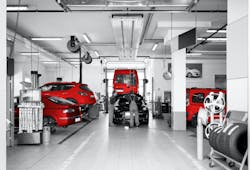Why is Everyone Talking about OEM Guidelines?
Original equipment manufacturer (OEM) repair guidelines have moved to the forefront of the industry in recent years. Although manufacturer guidelines on how to repair their vehicles have always been around, the industry has put more emphasis on the importance of ensuring the initial engineering and integrity of the vehicle remains intact.
A variety of reasons have affected OEM repair guidelines in industry discussion. Prominent lawsuits, new legislation, OE manufacturer concerns in protecting their brand and even customer safety have all caused repair guidelines to grace industry publication headlines. The most influential reason affecting its importance, however, is technology.
Designed with more than just transportation in mind, vehicles are equipped with new technology that keeps consumers safe and comfortable. Whether it is lane departure warnings that prevent drivers from drifting out of their lanes or automatic lift gates that provide hands-free access into the trunk, vehicles are smarter than ever before. In the past, only luxury or foreign brands had innovative features embedded in their vehicles. Now, nearly all manufacturers have their vehicles (some even in base models) packed with the latest technologies. Incorporating these features into vehicle design has become mandatory for most brands because they are competing in a market with rising technological demands from consumers.
Because of these newly introduced advancements, manufacturers are updating their repair guidelines more frequently than ever before. Collision repairers have made significant investments in their facilities in order to keep up with the new equipment and training requirements. Furthermore, the repair process has undergone a substantial change because of these industry advancements. New steps, such as scanning and recalibration, have become tantamount in guaranteeing customer safety.
In addition to the rapid technological advancement in vehicles, materials have also advanced as well. Keeping vehicle weight down has provided many consumer benefits. From increasing fuel efficiency to offsetting the heavy weight of a battery in an electric car, materials matter. To keep automobiles light, manufacturers are using new types of materials like aluminum, carbon fiber and magnesium to build vehicles—ultimately saving the consumer money at the pump. The use of these materials is only growing, which is causing collision repairers to invest in the equipment and adjust their repair processes in order to get the vehicle back to pre-accident condition and safe to drive.
This is why keeping up with OEM repair guidelines has become so crucial. The rapid rate of advancement in both technology and materials has made collision repair more complex than ever. Guidelines set forth by the manufacturer provide a map to repairers on how to navigate the advancement and determine which repair components affect others.
As OEM repair guidelines continue to advance, it can be overwhelming to keep up. Below are some tips that will help any collision repair owner stay afloat in this rising tide of innovation:
- Join a premier network: CARSTAR, North America’s leading premier network of locally owned and operated repair centers, provides its family of franchise partners with resources like CARSTAR University that help stores stay ahead of OEM repair guidelines. Additionally, CARSTAR’s EDGE Performance Platform is the network’s operational program that helps stores implement, track and improve on not just OEM repair guidelines, but also other key industry performance indicators.
- Designate an in-store trainer: Is there a particular team member looking for additional responsibility or an opportunity to stand out? Challenge them to become your in-store subject matter expert. Provide them with the resources, subscriptions and contacts to have their finger on the pulse of new OEM updates and sharing the footnotes with you.
- Prioritize guidelines: Are you in a market that leans more toward a particular make? Ensure your facility is up to date on those guidelines. Do not put as much emphasis on the repair standards of manufacturers that your store has never seen.
- Weigh equipment return on investment: Blindly purchasing state-of-the-art equipment does not build a premier facility. It is important to weigh the return on investment for each purchase to make sure you are elevating yourself in your region. If there is a market for a particular repair set out in an OEM guideline that nobody else in your territory can fill, it may be worth it to invest in that equipment.
- Budget for training: Is aluminum welding a rising in need for your market? Purchasing the equipment is not enough as you need qualified technicians to perform these repairs. Invest in your staff and provide the chance for additional training—they will appreciate the opportunity.
New technology will continue to materialize in modern vehicles and those who are able to keep up in this state of constant evolution will emerge as the leaders in their region.
CARSTAR works closely with both vehicle manufacturers and its insurance partners to navigate this landscape to ensure a mutually agreed upon roadmap for success. To bring additional support to your facility or find more information on joining the CARSTAR family as a local owner and operator, call 844-906-9764 or visit CARSTAR.com/franchise-opportunities.
